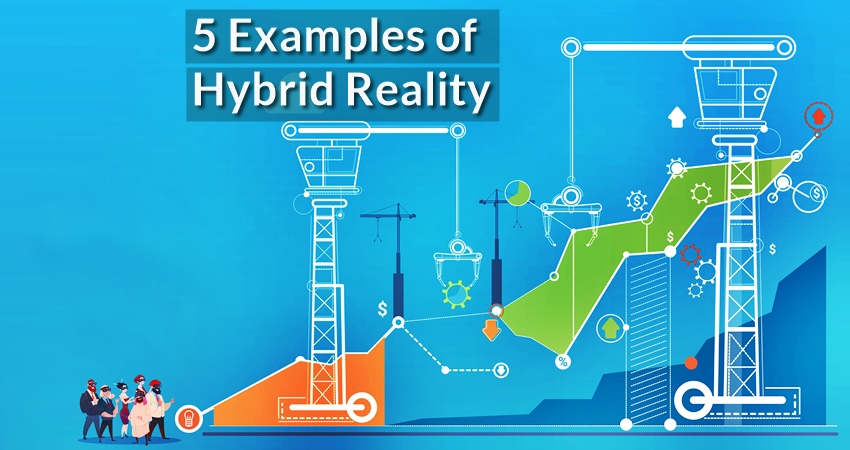Mixed Reality or Hybrid Reality is defined as integrating interactive digitalized objects with the user’s real-world environment.
Hybrid reality differs from augmented reality because rather than merely displaying images, herein you can very much interact and manipulate the graphics.
According to the Mordor Intelligence Research, “the global mixed reality market is expected to see a CAGR of 47.9% for 2019-2024.” Some of the major players of the Hybrid Reality are:
- Microsoft (Hololens 2)
- Google (with their new Glass Enterprise Edition 2.0)
- HP (HP Windows Mixed Reality Headset)
- Magic Leap (Magic leap One)
- MindMaze (Neuroscience and Mixed Reality)
Also read: A brief on AR, VR, and Mixed Reality Applications
Mixed reality combines or “merges” virtual and real worlds into a hybrid physical/digital environment in a functional manner. We’ll see below the top few examples of Hybrid Reality across various industries.
After the success of augmented reality through Pokemon Go, mixed reality is rapidly laying down its ground in the gaming zone too.
Since then many new hi-tech games have been developed in the gaming arena. Three of the most popular hybrid reality games in Windows mixed reality games are Arizona Sunshine, Crystal Rift, and Titan Slayer.
“Can You See Me Now?” or CYSMN is a mixed-reality game by Blast Theory and MRL (The Mixed Reality Lab). It is one of the first MR games developed in 2001 and also one of the 1st location-based games.
The game hybrids a location in physical space with the virtually generated environment while keeping the players connected in the hybrid shared environment throughout on real streets, with GPS tracked PDAs.
This hybrid reality game won the Golden Nica at the Prix Ars Electronica.
The mixed reality smart glass “Microsoft HoloLens 2” is a hybrid product of hardware and software working together, with spatial computing technologies.
The Hololens is mounted in the construction hard hat with the Trimble XR10 Connect software for HoloLens that possesses enhanced 3D design review and project management qualities.
Now, architects do not need to create the traditional scaled-down 3D BIMs.
The new MS Hololens 2 is a hard hat solution that enables onsite workers to review their models from multiple stakeholders and provides holographic data with precise alignment on the physical space in real-time.
Hybrid reality devices are helping medical professionals and healthcare centers in many new ways now.
MR integrates human vision with computer graphics generated through real-time images and shares patient records with updated data. MR technology is transforming modern surgical practices.
Surgeons use hybrid reality for real-time X-ray vision and Hololens with Philips’ image-guided therapy.
Pioneering procedures and improved outcomes are being formulated by running model cases and scenarios via mixed reality devices and techniques.
Mixed reality also helps patients with special needs or PTSD patients simulating a safer environment and understanding situations harmlessly.
A mixed holographic reality of the real thing is the best possible way of teaching and training purposes.
New Mixed reality devices, right now most famously the Microsoft HoloLens, provides the ability to teach and learn with real digitalized simulations in real-time.
For example, via 3D projections and simulations through Microsoft HoloLens, Case Western Reserve University medical students located in Cleveland, Ohio learns human anatomy.
The faculty can teach anatomy using a life-sized 3D visual of the real thing while being able to manipulate the same accordingly.
Retailers are bringing the shopping experience to life with the real-world features of hybrid reality. Now the shoppers, especially millennials, are more inclined towards online shopping and buying, but that also means the lack of real view experience.
Even if someone shops local, buying in bulk to see if the product goes with your other furniture is not an ideal solution.
Many e-commerce companies like Startup Boxed and Wayfair are expanding into the online wholesale space by leveraging mixed reality.
With the help of MagicLeap, Wayfair is providing its customers with a mixed reality shopping experience. But, the price tag of (starting at $2,295) Magic Leap One headset is one of its drawbacks.
Still, the mixed reality in the e-commerce market is building up its reputation for smooth and super effective selling and branding point.
Creation of Magic Leap, the headset allows a shopper to view and interact with the products in their exact size in a realistic manner.
You May Also Like To Read-
What is the Metaverse? Know about its emergence in Augmented Reality
Understanding the Applications and Role of AR in Manufacturing Industry


